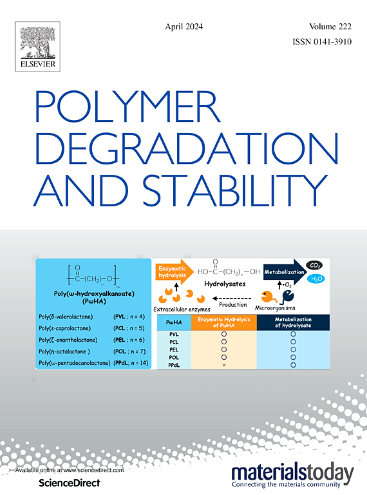Iminodiacetic acid enhances the mechanical and degradation properties of copolyesters by hydrogen bonding and branching
IF 6.3
2区 化学
Q1 POLYMER SCIENCE
引用次数: 0
Abstract
The development of biodegradable polyester materials is of great significance in alleviating the problem of plastic pollution. Poly(butylene terephthalate adipate) (PBAT) is a typical aliphatic-aromatic copolyester and has a capacity of several hundred thousand tons per year. However, the relatively low mechanical strength and high requirement for degradation environment of PBAT limit its application fields. To compensate for the deficiencies in mechanical and degradable properties of PBAT, this study reports a molecular chain structure design on the amorphous region using diethyl iminodiacetate (DEI). A series of poly(butylene adipate iminodiacetate terephthalate) (PBAIT) with a DEI content of 5–20 mol% were obtained. DEI contains secondary amine groups, which can be amidated with ester bonds to produce branched sites, and branched structures can be formed from 75 to 79 % of DEI during the copolymerization process. PBAIT-10 exhibit better tensile strength (23.87 MPa), tensile modulus (108.2 MPa) and hydrophilicity than those of PBAT. In addition, PBAIT-10 also shows very high toughness, with an elongation at break of over 1000 %. PBAITs can be degraded in enzymatic or hydrolytic environments. The degradation mechanism was analyzed by 1H NMR spectra and FTIR, and further combined with 2D-IR analysis, which reveals the rapid degradation of the BI chain segments regardless of whether or not they form branched sites. This work provides an idea to prepare copolyesters that combine good mechanical properties with degradability under mild conditions.

求助全文
约1分钟内获得全文
求助全文
来源期刊

Polymer Degradation and Stability
化学-高分子科学
CiteScore
10.10
自引率
10.20%
发文量
325
审稿时长
23 days
期刊介绍:
Polymer Degradation and Stability deals with the degradation reactions and their control which are a major preoccupation of practitioners of the many and diverse aspects of modern polymer technology.
Deteriorative reactions occur during processing, when polymers are subjected to heat, oxygen and mechanical stress, and during the useful life of the materials when oxygen and sunlight are the most important degradative agencies. In more specialised applications, degradation may be induced by high energy radiation, ozone, atmospheric pollutants, mechanical stress, biological action, hydrolysis and many other influences. The mechanisms of these reactions and stabilisation processes must be understood if the technology and application of polymers are to continue to advance. The reporting of investigations of this kind is therefore a major function of this journal.
However there are also new developments in polymer technology in which degradation processes find positive applications. For example, photodegradable plastics are now available, the recycling of polymeric products will become increasingly important, degradation and combustion studies are involved in the definition of the fire hazards which are associated with polymeric materials and the microelectronics industry is vitally dependent upon polymer degradation in the manufacture of its circuitry. Polymer properties may also be improved by processes like curing and grafting, the chemistry of which can be closely related to that which causes physical deterioration in other circumstances.
 求助内容:
求助内容: 应助结果提醒方式:
应助结果提醒方式:


